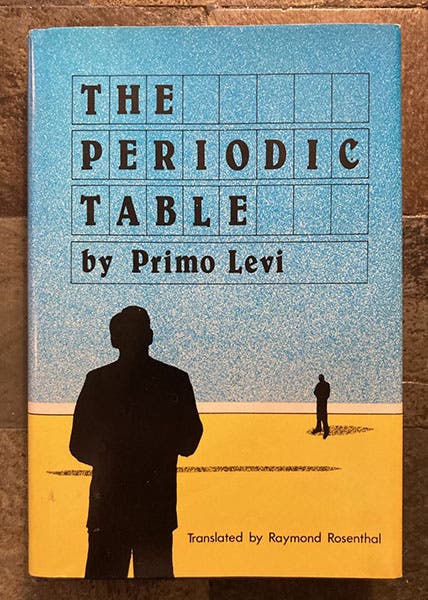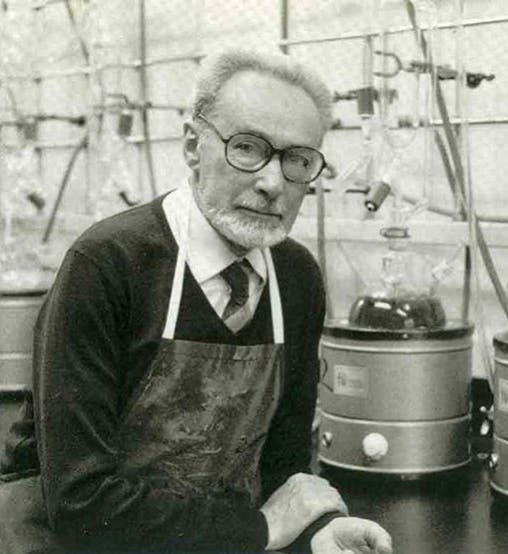Scientist of the Day - Primo Levi
Primo Levi, a Jewish Italian writer and chemist, died Apr. 11, 1987, at age 67. Levi lived most of his life in Turin in the Piedmont area of Italy, and went to school there, studying chemistry at the University of Turin. Life became more difficult with the rise of fascism and the enactment of laws restricting the employment and education of Jews. At the time of his graduation in 1941, it was forbidden to hire Jews, but he managed to get a job as a chemist for a mining company outside Turin, and then one working for a Swiss firm in Milan. Although frail as a child, he took to rock climbing as a young man, which provided him with survival skills when Germany took over Italy in 1943 and restored Mussolini to power. Levi took his family into hiding and joined the Italian Resistance, but his resistance was brief, for he was caught and arrested in late 1943, and shipped to Auschwitz in Poland, where he spent 11 months as a prisoner of war. He survived only because he was a chemist and employable in the IG Farben chemical plant near Auschwitz. As the Russian front neared Auschwitz in early 1945, the bulk of the prisoners were marched west, to their deaths, and Levi survived this time only because he had scarlet fever and was too sick to walk. When he was finally freed and returned to Turin, he was a skeleton of his former self. But he did recover, and by 1947, he had written and published an account of his experiences at Auschwitz, If This is a Man. He would write a second volume about his life as a prisoner of war, while earning his living as an industrial chemist, working for a paint manufacturer. He would continue at the paint factory until 1974, writing and publishing short stories all the while, until he retired to write full time.

The Periodic Table, by Primo Levi, New York, Schocken Books, first edition, 1984 (author’s copy)
One of the first products of his retirement was Il sistema periodico, published in 1975, and translated into English in 1984 as The Periodic Table, and it is this book that merits our attention today. It is a collection of true stories, mostly autobiographical, each of which is centered around, and named after, an element, so we have chapters called "Argon," Hydrogen", Zinc,” “Arsenic,” etc. In “Potassium,” Levi told a story from his fourth year as a chemistry major at Turin, when he was taking a required course in physics for chemists. He was given the chance to prepare some distilled benzene for the physics teaching assistant. The manuals said that for the final distillation, a small piece of sodium should be inserted into the flask, to absorb any remaining water. Levi scoured the Institute for sodium, and could find only a small packet of potassium, which has properties similar to those of sodium. So he put a “half-pea-size” pellet of potassium in the flask, did the final distillation, removed the pellet and buried it outside, and then attempted to wash out the flask. But he had missed a tiny flake of potassium, and when the water touched it, it burst into flame, ignited vapors still in the flask, and shot out a blowtorch that set fire to the curtains and nearly burned the place down. The moral: “almost the same” is not “the same”. Sodium would not have ignited this way. In chemistry, details are everything, and substitutions can have disastrous consequences. The precision of chemistry is the theme for several of the stories. In “Chromium,” Levi is hired after the war by a paint company and given the task of figuring out why a batch of paint had “livered,” turning to jelly. Searching through the records, Levi found that the paint recipe stipulated the addition of “2 or 3 drops” of a certain reagent. When the recipe card was copied and recopied, somehow the “2 or 3” became “23 drops”, and the extra 20 drops had caused the paint failure.
Each of the stories is graced by Levi’s reflections on life, death, human kindness and wickedness, and the vicissitudes of fate. One of the most sobering is “Cerium,” as it is set at Auschwitz. In order to survive in any of the Lager, one had to steal things that could be bartered for bread, otherwise one would die from malnutrition. In the lab at IG Farber, Levi found an unmarked jar with 20 small rods inside, one of which he took back to the camp to analyze. When scraped with a knife, it produced a shower of sparks, indicating that it was a cerium-iron alloy, whose sole use was as an igniter in cigarette lighters and acetylene torches. There was a black-market industry at Auschwitz making cigarette lighters for camp officials, so the rods could be traded for bread. But they were the wrong size, and had to be scraped down to the right diameter before they could be traded. So he and his collaborator spent endless nights, under their blankets in their straw beds, scraping and scraping until each rod would fit through a hole in a template. Somehow they managed not to set their beds on fire. Levi firmly stated that, without the bread their cerium rods brought them, he would not have survived Auschwitz.
Finally, I will mention "Vanadium", set much later in Levi’s life, where he described how his employer, the paint factory, had received a shipment of resin from a German supplier, which proved unsuitable for the varnish they were trying to produce. In correspondence from the German factory, the German representative suggested that they add a touch of vanadium naptenate as a drying catalyst. The word naptenate (it should have been naphthenate) brought back a flood of memories to Levi, who remembered a German chemist at Auschwitz who had also mispronounced the word, and it turned out that the two were one and the same. The essay developed from there, as Levi tried to figure out whether he should confront this figure from his unthinkable past. I will not spoil it further for those who might like to read it.
The Periodic Table was voted the best science book ever written in a poll conducted by Great Britain's Royal Institution in 2006, which I ordinarily would not take seriously, since 9 of the 10 finalists were by authors still living, which is ridiculous. But of all the books on the list, The Periodic Table was indeed the most deserving of a prize. I have read it many times, and learned something new on each reading. My deep admiration of Primo Levi has never faltered.
Levi, whose health failed in his final years, died in a fall from a balcony in his apartment building in 1987. His death was ruled a suicide, but many think it was accidental, and those who are skeptical would include me. A man who survived fascist Italy and Auschwitz would seem unlikely to give himself up easily to death.
Dr. William B. Ashworth, Jr., Consultant for the History of Science, Linda Hall Library and Associate Professor emeritus, Department of History, University of Missouri-Kansas City. Comments or corrections are welcome; please direct to ashworthw@umkc.edu.







